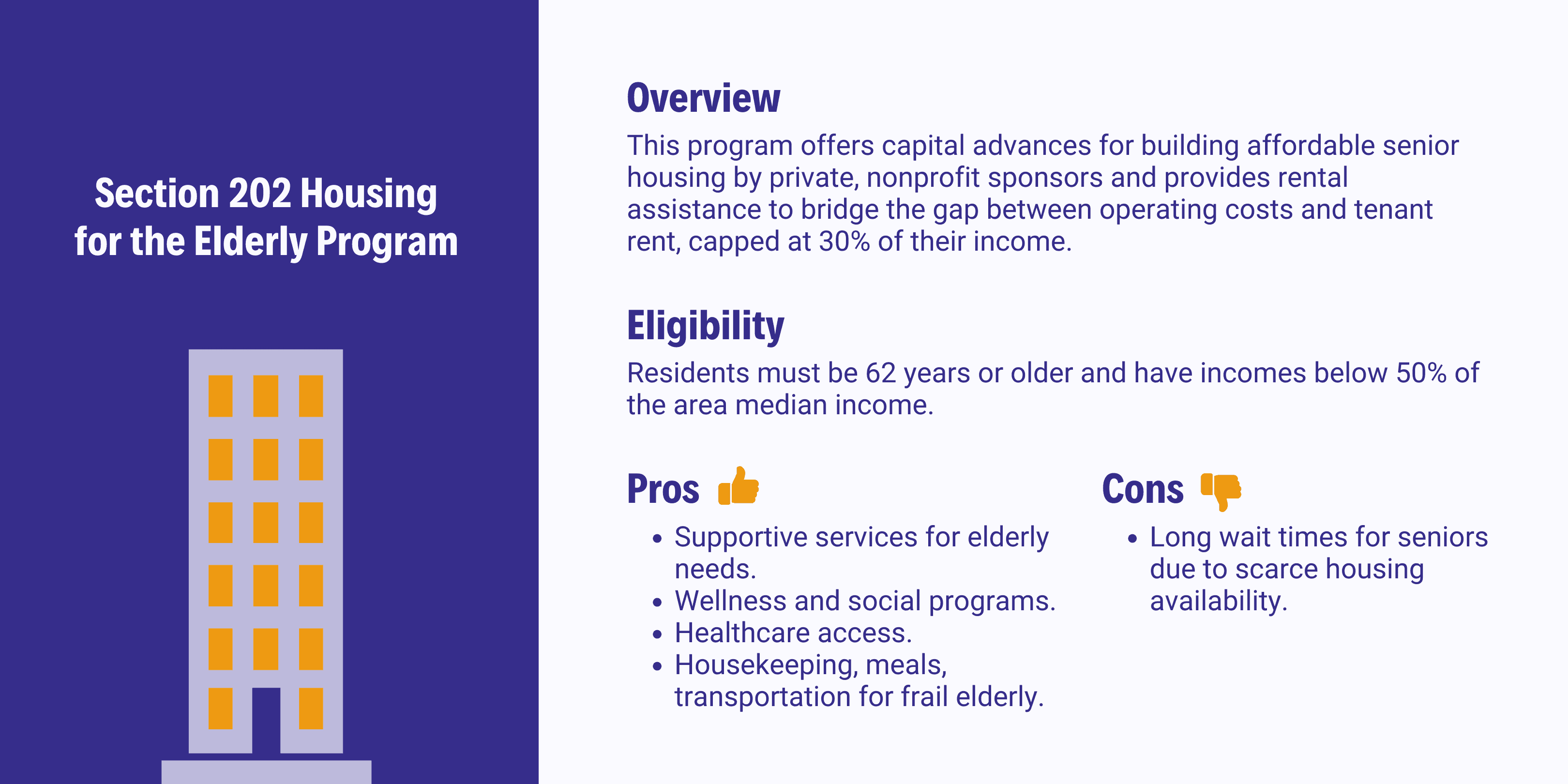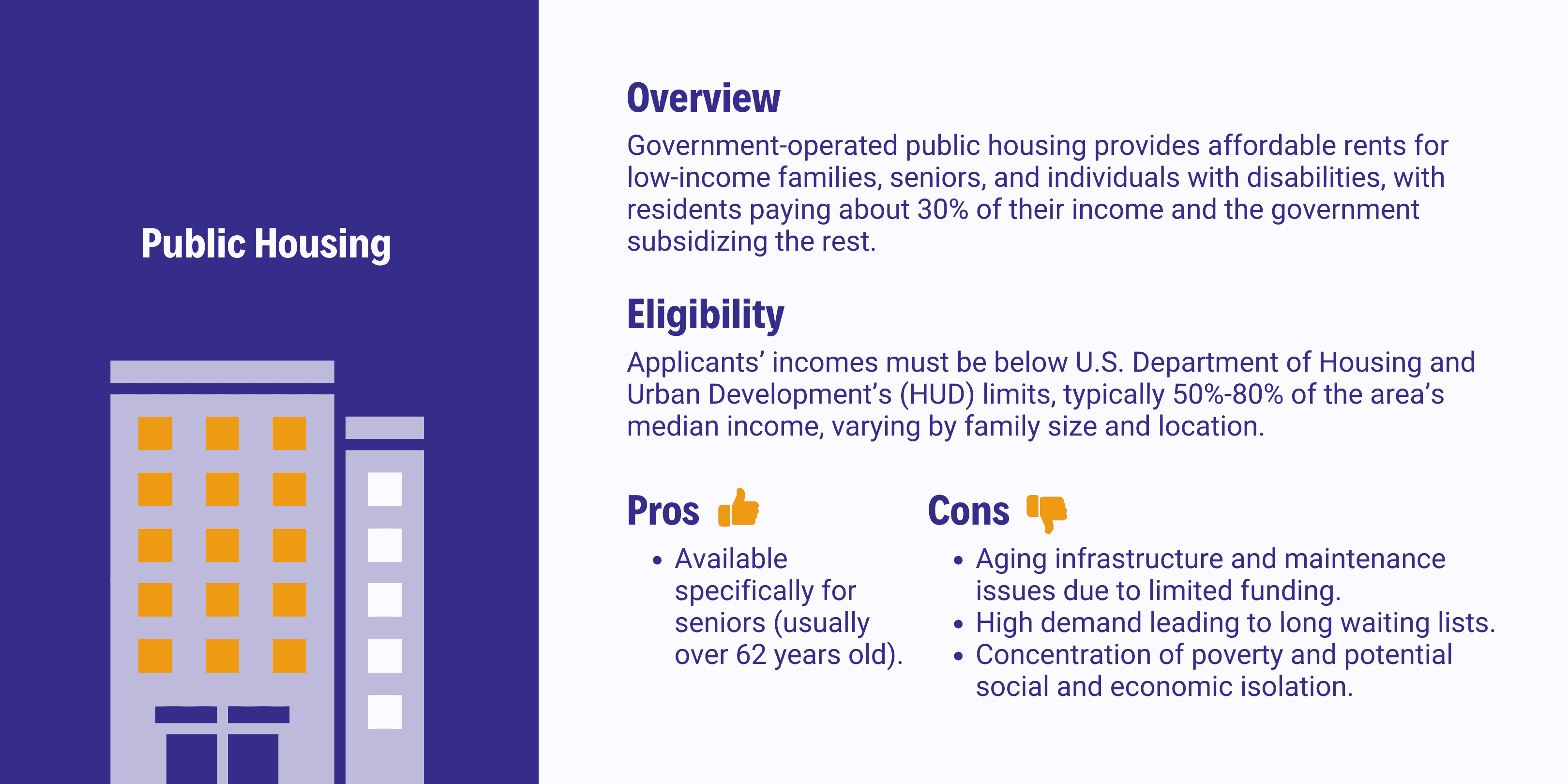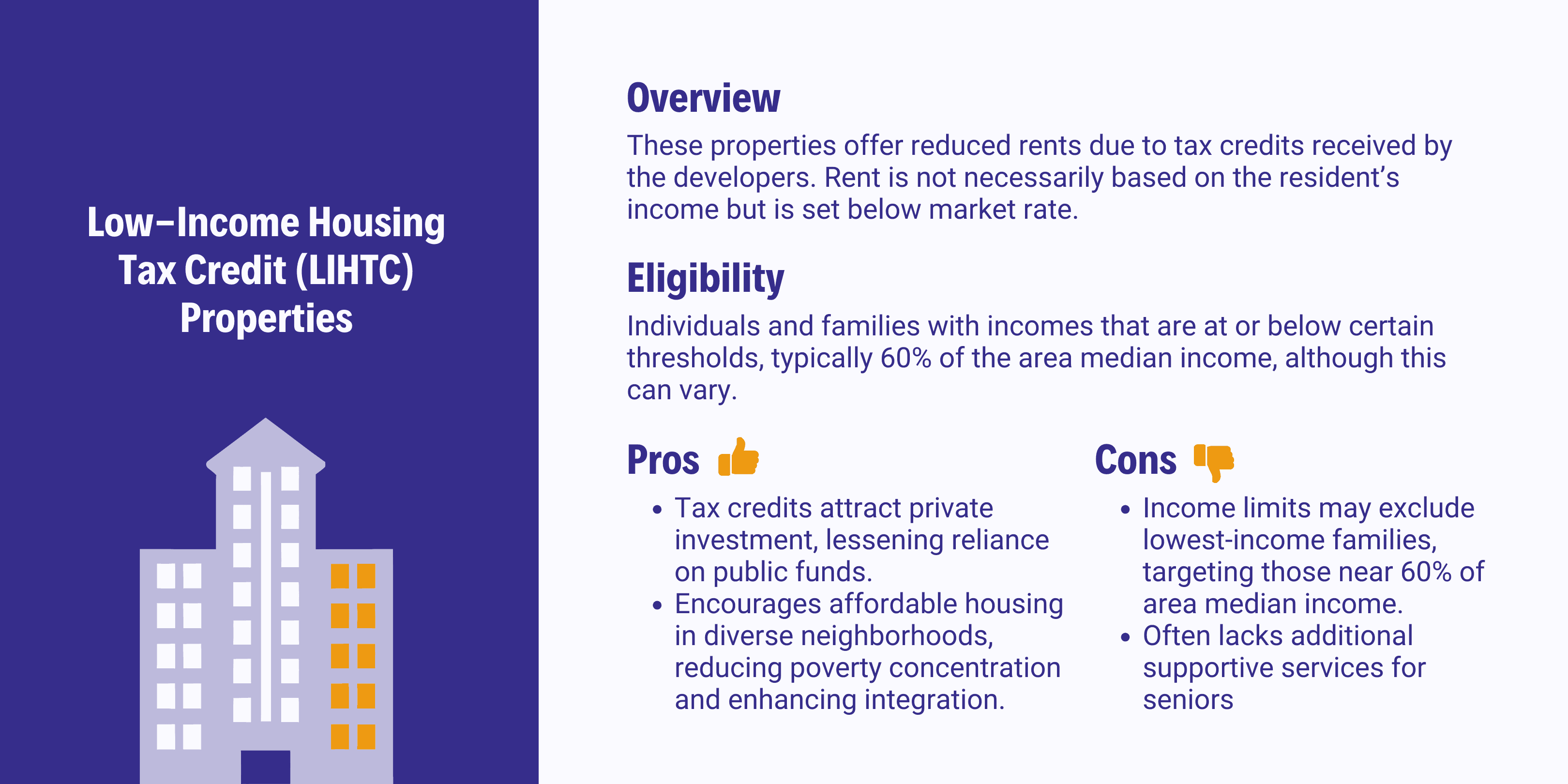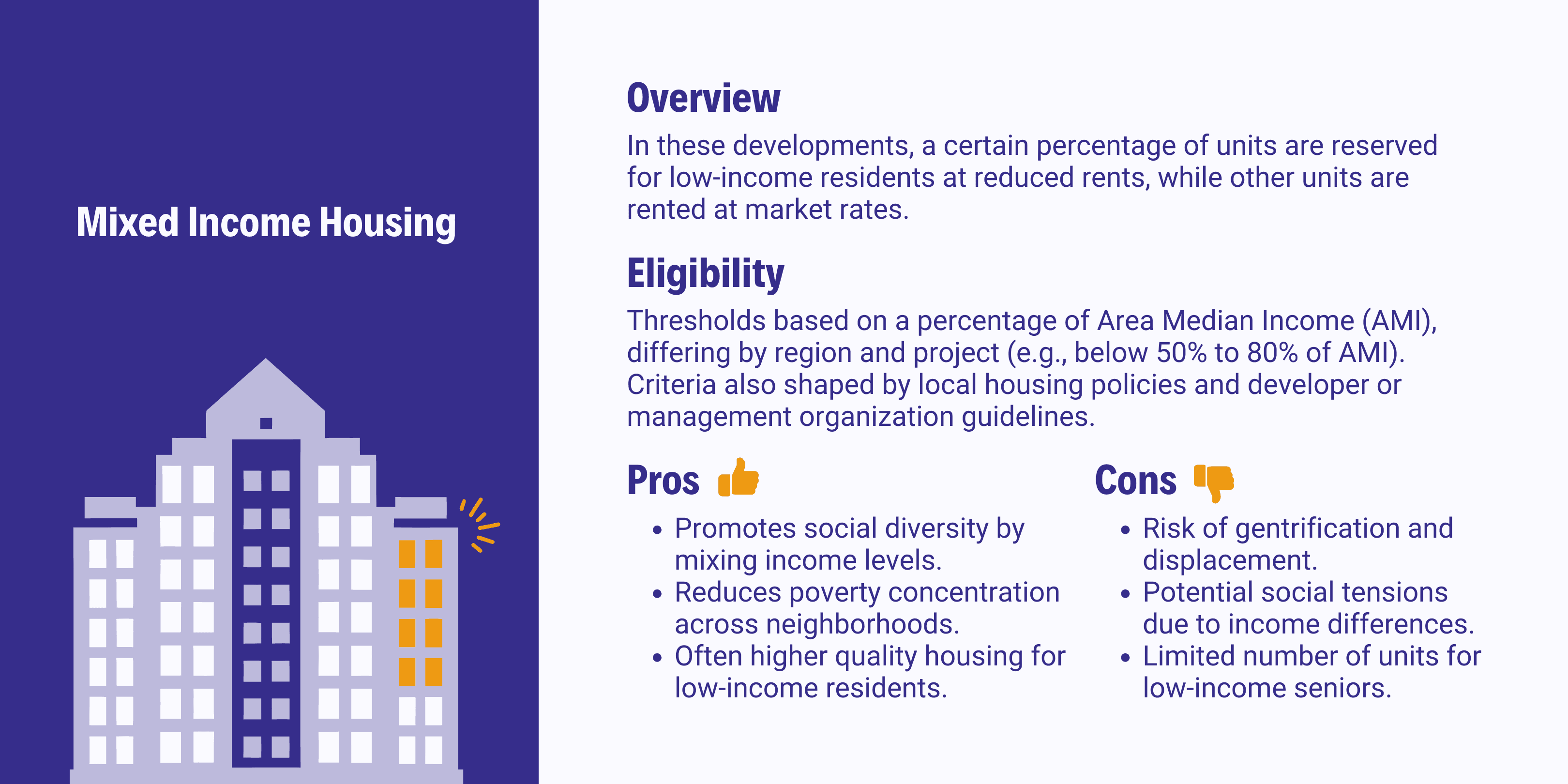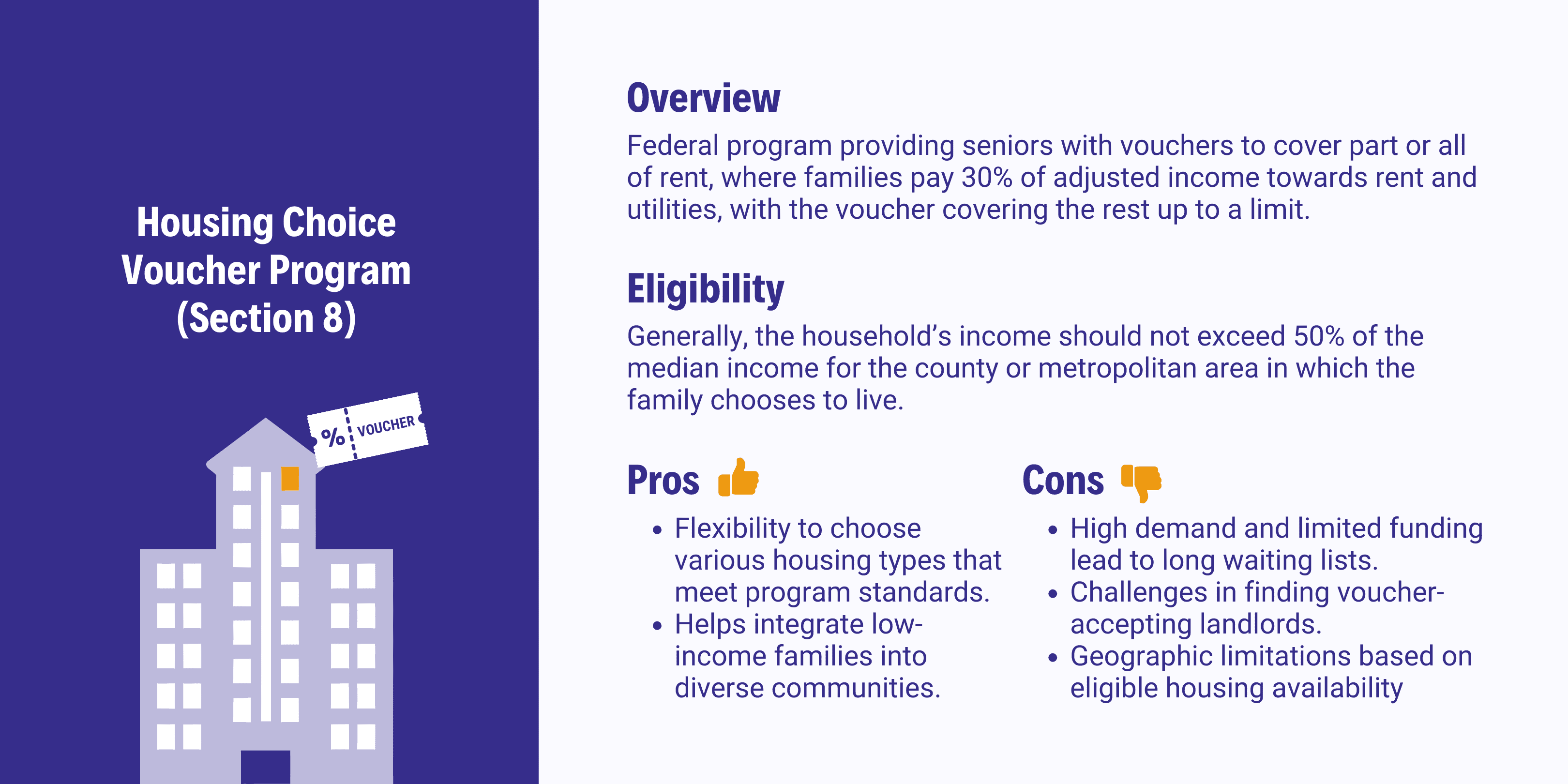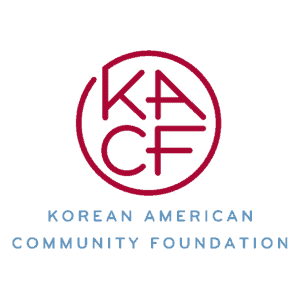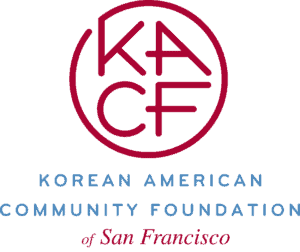Toward Better Aging
A National Study of Korean Older Adults
BY LINYING HE, DENA LI, AND YUNCHENG WANG
Introduction
Today, the U.S. population is aging more than ever before. It’s expected that the number of Americans aged 65 and older will grow from 58 million in 2022 to 82 million by 2050, marking a 47% increase. Concurrently, the proportion of the total population within this age group is set to increase from 17% to 23%. In this context, the Korean population over 65 years old in the U.S. has increased by 69% in the last decade, reflecting the rapid changes in the demographics of the country. However, they are often marginalized in gerontological research and policy making, and their specific cultural, language, and health care needs are overlooked. More attention is critical, especially considering that 73% of these older adults have limited English proficiency, and 39% are low-income. By including Korean older adults in research and policy-making, we can better understand and address their unique needs, tap into their rich knowledge and experience, and foster mutual learning and collaboration across generations and cultures.
This report aims to fill this gap by providing a thorough and pioneering analysis of Korean American seniors based on in-language surveys and focus groups conducted across 7 study areas. It explores various aspects of their lives such as housing, caregiving, transportation, finance, healthcare, and social engagement. The study identifies the unique challenges faced by these seniors in accessing vital services and provides new insights into their daily life experiences and needs. These findings are crucial for bridging existing policy gaps and better serving this demographic.
Survey and Focus Group Findings

Housing 주거
Ensuring housing is key for seniors to age safely, comfortably, and independently in their own homes. Good housing means they can easily get the help and care they need and live in a place that suits them even as their health changes. The majority of those surveyed and who participated in the focus groups reside at home with their partner and are content with their living situation. They value living independently in their own homes where many of them enjoy the convenience, safety, and proximity to healthcare services and a familiar linguistic and cultural setting. 51% of the survey respondents still prefer to live in their current homes even when long-term care is needed (Chart 1).
Chart 1
What is your ideal living arrangement when long-term care is needed?
장기 요양이 필요할 경우 어디에서 지내고 싶으신가요?
For many, a necessary part of living independently is safety at home, especially in accident-prone areas like stairs and bathrooms. 28% of survey participants acknowledged the need for home adjustments to ensure comfort while aging. Bathroom modifications, alarm systems, handrails, and the addition of wheelchair ramps were especially in demand.
Additionally, for those who choose to live on their own, staying close to family and friends is also highly valued. Many participants in the focus group recounted health emergencies and how important it is for them to have support close by when it matters most. Living close to loved ones, such as in the same apartment complex with friends, is also seen as a way to combat loneliness.
“Now, let’s talk about people who live alone… Recently, I experienced a headache that persisted for three days. Concerned, I reached out to my niece. She arrived promptly and contacted the hospital. Following their advice, she called an ambulance to transport me there. It’s hard to imagine what I would have done without someone to call for help.”
– San Francisco focus group participant
Moving away from their cherished homes and support networks is difficult for many. However, high expenses prompt many of them to consider downsizing or relocating. In New York City, where 70% of surveyed individuals rent, over half of these tenants are rent-burdened as they allocate more than 30% of their monthly income to rent. Individuals with limited English proficiency, lower levels of education, or those without citizenship status are also more likely to be rent-burdened.
The challenge of upkeeping larger properties also prompts some to consider relocating, particularly residents of less densely populated areas. In Houston, for example, 66% of survey respondents live in large homes with four or more rooms. The burden of maintaining these properties is a significant reason for considering a move. When considering a move, Korean seniors often look for communities with the familiar comforts of a common language and culture. Other important factors influencing their decision include affordability, familiarity with the area, and availability of healthcare services. However, with the high demand for housing that caters to these needs, Korean older adults are often faced with long waitlists.
“I put in for a senior apartment, which normally has a 5-year waitlist. I’ve called a bunch to hurry it along because I need it sooner, but no luck yet—I guess I’m stuck waiting.”
– Houston focus group participant
Figure 1
Senior Living Options: A Comparison of Care and Independence Levels
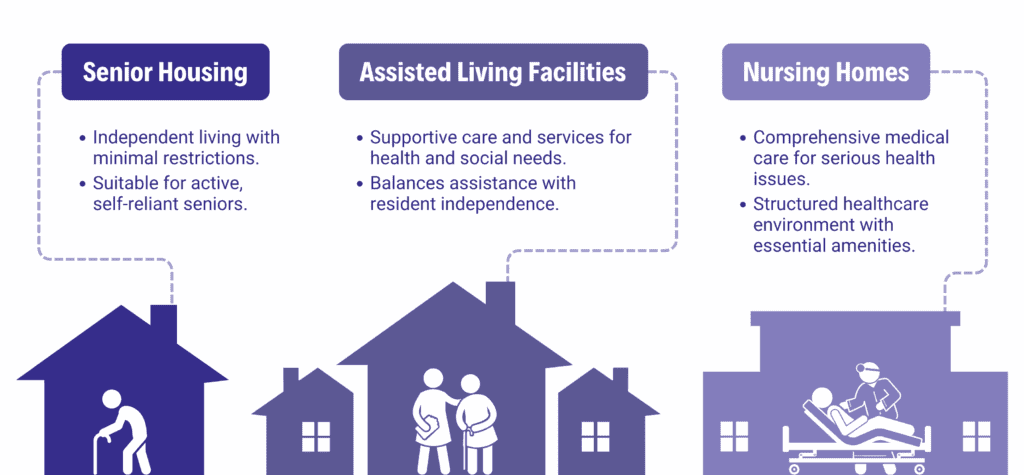
During the focus group sessions, it was evident that many participants were unclear about the difference between assisted living and nursing homes. Although assisted living facilities are designed to support residents’ independence, the idea of moving into assisted living was often associated with fears of losing autonomy and facing difficult end-of-life decisions. Reflecting this sentiment, only 25% of survey respondents preferred assisted living as an option for long-term care in case they needed it. Despite not considering it the preferred option, 58% recognize assisted living as a viable alternative, understanding that home care, which allows individuals to live independently in their own homes, may not be practical for their future needs. This acknowledgment comes from the realization that their conditions might necessitate care beyond what home care can provide. Among these individuals, 33% cite cost as the primary factor influencing their choice of an assisted living facility, followed by proximity to family and friends, access to familiar food, language, cultural, and religious activities (Chart 2).
Chart 2
If you have considered living in assisted living apartment/commuinity, what are the most important factors for you to choose one? Select all that apply:
선택을 고려 해 본적이 있다면, 시니어 보조 아파트/커뮤니티를 선택하는 데 가장 중요한 요소는 무엇입니까? 해당되는 모든 것들을 고르세요:
Participants in the focus groups were eager to learn more about the services offered by local assisted living facilities. Similar to survey participants, they face several barriers to understanding and accessing these options. One of them highlighted by the San Francisco focus group is the steep monthly cost of $7,000 to $8,000 at these facilities. Another one is the language and cultural gap. Without staff who can speak Korean and understand their culture, seniors who are not fluent in English struggle to express their needs, especially regarding dietary preferences, social customs, and healthcare practices. These challenges affect their emotional and mental health and make it difficult for them to adapt to the facility’s routines and practices.

Caregiving 간병
Traditionally, the concept of filial piety in Korea has been closely associated with the practice of multiple generations living with and caring for aging parents. Today, filial piety focuses more on respect and support for the independence of seniors. Focus group discussions reflected this cultural shift. People preferred to get care from their own generation, which meant depending on non-family support over inter-generational family care.
Chart 3
When help is needed for your daily activities, whom or where do you resort to for help?
일상 활동에 도움이 필요할 때누구에게 도움을 요청합니까?
82% of the survey respondents have a clear preference for familial care, particularly from spouses over children (Chart 3). At the same time, elders recognize the potential for substantial physical and emotional strain on their caregivers. While these challenges vary depending on the individual’s health and the extent to which the family is involved in their care, focus group participants were unanimous in urging more recognition and support for caregivers. However, many Korean elders are not aware that their caregivers may be eligible to receive an allowance under Medicaid. Even for those who are familiar with the system, applying for and maintaining eligibility for Medicaid and similar programs can still be difficult. Moreover, keeping detailed records and going through regular reassessments can be especially hard for individuals who are not fluent in English. This challenge is worsened by the lack of resources and support systems available to help seniors with these complicated processes (Box 1).
Box 1
Challenges of Applying for Caregiver Allowances
Medicaid Eligibility: Determining eligibility can be complex, involving assessments of income, assets, and medical needs. Ensuring that the care recipient qualifies without jeopardizing their future eligibility also requires careful planning.
Home and Community-Based Services (HCBS) Waivers: Many states offer HCBS waivers under Medicaid. These waivers may cover services like home health aides, personal care, and caregiver respite, and sometimes allow family members to be paid as caregivers. Understanding and accessing these waivers can be difficult.
Caregiver Assessment and Training: Family caregivers may need to complete assessments or training to qualify for financial support. They must manage their caregiving duties alongside finding the time to meet these requirements. Non-native English speakers or those from different cultures might find language and cultural barriers in the training and assessments challenging.
Tax Implications: Receiving a caregiver allowance can have tax implications. Understanding how caregiver allowances are taxed for both the caregiver and the care recipient can be confusing and might require professional advice.
Legal and Contractual Requirements: Legal aspects, such as drafting caregiver agreements and understanding the implications of a family member being a paid caregiver, can be complex.
Financial and Asset Considerations: Medicaid’s strict rules about income and asset transfers can pose challenges in maintaining eligibility while receiving a caregiver allowance.
The challenges of wanting to age at home, which adds more responsibilities that family members may not be properly equipped to handle, motivates some older adults to consider professional caregiving services. When asked about the main obstacles in getting these services, 43% of people mentioned not having enough information and 42% pointed to language issues. Financial difficulties (16%) and cultural stigma (15%) were also notable concerns (Chart 4).
Chart 4
Are there any difficulties in accessing the professional caregiving you need? Select all that apply:
필요한 전문적인 간병 서비스를 받는 데 어려움이 있나요? 해당되는 모든 것들을 고르세요:
Effective communication is essential in caregiving, but language barriers can significantly hinder interactions between Korean seniors and caregivers who do not speak Korean. This often leads to misunderstandings and a weakened sense of connection. Such communication challenges can exacerbate trust issues, particularly when vulnerable seniors must depend on unfamiliar individuals for intimate care. Additionally, it is often difficult to find caregivers who not only speak Korean but are also culturally attuned to the unique needs and preferences of Korean older adults. Cultural competence in caregiving encompasses more than just language skills; it requires an understanding of specific cultural norms and values.
In addition to these difficulties, professional caregiving services can be prohibitively expensive, particularly for Korean seniors who are on a tight budget or fixed income. This financial strain may force them to ask their children for financial support. However, many seniors resist such external help, often out of pride or unwillingness to burden their children.

Transportation 교통
Most Korean American seniors prefer “aging in place,” which often means living in places where daily activities require frequent car travel. 78% of those surveyed and the majority in the focus groups identified driving as their main mode of transportation. However, this percentage decreased to 68% among those aged 75 and over. While younger participants in the focus groups reported no major issues with driving, a few mentioned this was not the case for their parents. Some of the older participants have also faced difficulties with driving because of deteriorating eyesight and illnesses such as macular degeneration. Some focus group members were worried about driving, particularly at night, yet were reluctant to give it up entirely. A key reason many seniors keep driving despite these worries is the absence of convenient public transport, especially in the suburbs where they live. Giving up on driving without a practical alternative could lead to a loss of independence, increased isolation, a decline in their quality of life, and possible economic hardship.
Figure 2
How Lack of Driving and Transit Options Affects Seniors’ Well-Being
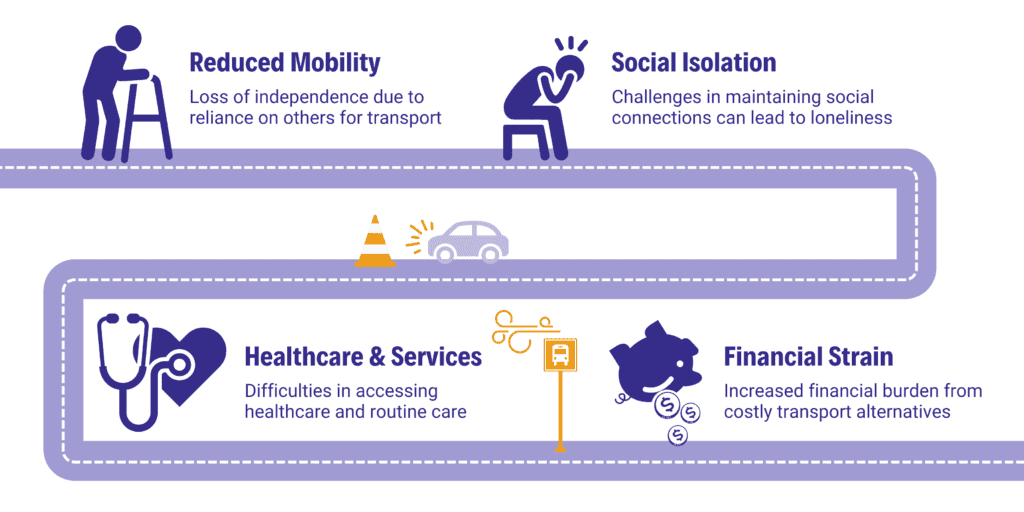
“A lot of the older folks I meet are on their own and still behind the wheel. They keep traffic tickets from their kids, scared they’ll be told to quit driving and lose their freedom to get around for simple stuff like hitting the market.”
– Houston focus group participant
Inevitably, as their ability to drive diminishes or disappears over time, more older adults start relying on public transportation to maintain their independence for as long as possible. However, only 32% of survey participants found public transportation at least somewhat convenient. The survey revealed several key reasons why seniors either avoid using public transportation or are not completely satisfied with it (Chart 5):
Distance to Bus or Train Stations (40%): A significant number of seniors feel they cannot travel safely or comfortably to the nearest bus or train station because they are too far away. This issue is particularly acute for those with mobility issues or those living in suburban or rural areas where public transport is scarce.
Safety Concerns (25%): Seniors are concerned about their personal safety while waiting at bus stops or train stations, especially during the evening or early morning hours. They also worry about safety in the vehicles, such as falls or being in close contact with strangers.
Accessibility of Stations (13%): The lack of elevators, escalators, ramps, and other aids for those with mobility challenges can be a barrier for many older adults. Poorly designed stations can be difficult to navigate for seniors with walkers, wheelchairs, or other mobility aids.
Cost (6%): While a smaller percentage, cost is still a factor for some seniors. Even though public transportation is often cheaper than owning and maintaining a car, the cost can still be a burden, especially for those on a fixed income. This is particularly true in areas where public transportation fares are higher.
Beyond these primary concerns, other factors may influence seniors’ reluctance to use or dissatisfaction with public transportation. These include unreliable service schedules, long wait times, uncomfortable or overcrowded vehicles, and the complexity of navigating different routes or transfer points. Additionally, some seniors may have health conditions that make public transport use more challenging, such as cognitive impairments or chronic illnesses that require frequent restroom access or make it difficult to stand for long periods.
There were some positive experiences with public transportation in certain areas, such as convenient and frequent rides in New York City and reduced or free fares on Houston METRO buses. However, more often than not, focus group participants found public transportation inconvenient, difficult to access in their neighborhoods, and potentially unsafe, especially during late hours.
Chart 5
If you do not use public transportation or are not completely satisfied with public transportation, what are the reasons? Select all that apply.
대중교통을 이용하지 않거나 대중교통 이용에 만족하지 못한다면 그 이유는 무엇입니까? 해당되는 것들을 모두 고르십시오.
Some focus group members discussed ridesharing instead of taking public transit, but they still faced hurdles. Many older adults struggle with smartphones and apps, crucial for ridesharing, and find it hard to adapt to these tech tools. Another drawback is that ridesharing can be more expensive than driving or public transit, especially if used frequently or to travel long distances. Also for Korean seniors who don’t speak much English, language issues and cultural differences with drivers can complicate the experience.

Finance 금융
Korean seniors over 65 in the U.S. typically have lower wealth, income, and retirement benefits than the average American senior. A large portion of these Korean seniors are also immigrants, impacting their Social Security eligibility and benefits due to factors like citizenship status, English proficiency, and duration of U.S. residency. Consequently, Korean seniors are often less likely to receive Social Security income than their counterparts in the general senior population, and those who do usually get smaller amounts. For instance, in New York City in 2022, 32% of Korean seniors did not receive Social Security income, compared to 26% of all New York City seniors. Additionally, the median household income of Korean seniors in New York City was $35,541 in 2022, significantly less than the median household income of the city’s overall seniors at $57,058.
Among survey respondents, only 40% felt their current income was enough to cover basic necessities. Their main concern was the rising cost of living, especially the high prices of housing, healthcare, gas, and inflation, which would affect their quality of life in retirement (Chart 6). As a result, similar to other groups, Korean American seniors are choosing to retire later. Among the survey participants, 27% are employed part-time and 18% full-time. Even for those over 65 years old, 14% work part-time, and 10% work full-time. As the cost of living rises, Korean seniors are staying in the workforce for longer to ensure their savings and retirement funds can support their desired lifestyles. In particular, those who immigrated to the U.S. later in life have had less time to build up retirement savings in the U.S. system and may need to work longer to establish a more secure financial foundation.
Chart 6
If your income partially covers or fails to meet your basic needs, please identify which of these needs are not being fulfilled. Check all that apply: 소득수준이 기본적 사항을 충족하지 못한다고 하면, 아래 사항 중 어떤 부분이 부족한가요? 해당되는 모든 사항을 고르세요:
Based on U.S. Census data, Social Security income constitutes approximately 50% of the household income for the average Korean senior. However, for Korean senior households in the lowest 10 percentile of income, this figure rises to around 70%. In contrast, retirement income accounts for less than 10% of household income for Korean seniors in most study areas. Notably, in regions like New York City and the D.C. metropolitan area, Korean senior households within the lowest 10% income bracket do not receive any retirement income at all.
Korean seniors in the focus groups overcame their usual reluctance to talk about their personal financial challenges. Focus group participants echoed the difficulties of depending mostly or entirely on Social Security benefits and expressed concerns about future financial stability. They highlighted the need for diverse retirement income sources, early and practical planning, and consulting financial experts for a secure retirement.
“I had scheduled my retirement in the U.S. for the age of 80 and accordingly arranged my financial plans. However, this turned out to be a significant oversight. It’s crucial to factor in inflation and the potential of falling ill post-retirement when preparing for these years.”
– New Jersey focus group participant

Healthcare 보건 의료
Like many older adults, Korean seniors are susceptible to certain chronic conditions. Survey participants most commonly had high cholesterol, hypertension, diabetes, eye diseases, and arthritis (Chart 7). Unfortunately, a limited understanding of the U.S. healthcare system and the complexities of health insurance can lead to inadequate use of preventive services, delayed diagnoses, difficulties in understanding medical advice, and challenges in managing chronic conditions.
“Back in Korea, one hospital trip does it all, but here, hopping to different spots for care is a hassle and stressful if things get serious. Plus, juggling insurance with my basic English makes me wish I was more clued up on the language and how things work here.”
– New Jersey focus group participant
Chart 7
Do you suffer any of the following chronic conditions? Select all that apply:
다음과 같은 만성 질환을 앓고 있습니까? 해당되는 것들을 모두 고르세요:
These challenges are even harder to navigate in healthcare settings that do not provide Korean language support. Even with interpreters, problems with communication persist. Among survey participants, over 41% of them identified language barriers as the primary challenge in accessing healthcare (Chart 8). The difficulty of finding medical professionals who are fluent in the language and familiar with Korean culture and traditional medicine was also a point of discussion in the focus groups.
“Language is a major roadblock. Even with interpreters, stuff gets missed since really getting it often means growing up with the language. This messes with everything, like booking appointments or changing medications. Being able to talk things through clearly is super important.”
– Houston focus group participant
Chart 8
Any difficulties in accessing healthcare? Select all that apply:
의료 서비스 이용에 어려움이 있습니까? 해당되는 모든 것들을 고르세요:
After language barriers, the most common challenge for Korean seniors in accessing healthcare services is a lack of information (Chart 8). Most Korean seniors have public insurance like Medicaid and Medicare. However, many of them lack information on how to make the best use of these programs, especially for finding healthcare providers who accept Medicaid or Medicare and are culturally sensitive or Korean-speaking.
In addition to physical health concerns, there are rising mental health issues in the Korean senior community. Many elders regularly face language barriers and lack support networks, factors that also contribute to a sense of isolation. Among survey participants, almost one-third sometimes or always feel isolated or anxious. Over half of the survey respondents reported their feelings of isolation or anxiety have intensified since the start of the COVID-19 pandemic. During the early phases, when lockdown restrictions were at their strictest, many focus group participants felt as though they were experiencing a form of imprisonment due to their isolation.
“People feel helpless, extremely lonely, and isolated. It’s like a completely different world. Younger people have started going out again, but our community hasn’t fully reopened yet. When you go to crowded places, you still have to wear masks and be cautious. It feels like seniors are living on a remote island.”
– San Francisco focus group participant
Physical health issues, the surge in Anti-Asian hate crimes, and economic hardships have significantly impacted the mental well-being of our older adult population (Chart 9). During and following the pandemic, community-based organizations were key in providing mental health education and encouraging social activities among seniors. However, in Korean communities, there is a notable stigma attached to seeking mental health services, which is often viewed as a sign of weakness or moral failing. The complexities and limitations of insurance and the scarcity of Korean-speaking professionals also hinder Korean seniors from accessing mental health services.
Chart 9
Why do you think your feelings of isolation or anxiety have intensified since the start of the COVID-19 pandemic?
COVID-19팬데믹이 시작된 이후로 고립감이나 불안감이 심해진 이유는 무엇이라고 생각하십니까?
Like other underrepresented communities, Korean Americans have a higher risk of developing dementia than white Americans. In every focus group session, dementia was consistently highlighted as a major health concern. Participants discussed the connections between isolation, depression, and dementia, noting how these conditions often exacerbate each other. As dementia deteriorates cognitive functions, it often leads to increased isolation and loneliness. This isolation can, in turn, trigger depression, further accelerating the progression of the disease.
“My mom was in a nursing home covered by her pension, but her dementia led to issues and ER visits, and she was eventually not allowed back. As her condition declined, affordable nursing homes were hard to find, with costs between $4,000-$5,000, beyond what we could afford.”
– Los Angeles focus group participant
Box 2
Dementia Challenges for Korean Seniors
Early Stage Challenges:
There may be a lack of understanding about dementia, its symptoms, and its progression among family members and the wider community. Patients may deny or minimize early signs of cognitive decline for fear of cultural stigma, which can delay diagnosis and intervention.
Middle Stage Challenges:
As dementia progresses, communicating with words can become harder. This loss of language can be especially difficult for older adults who don’t speak English. Individuals are not only isolated by language and cultural barriers but also by their worsening dementia.
Late Stage Challenges:
In the late stages, individuals require more intensive care, which might be beyond the capability of family members. Families may face emotional distress and financial hardship from long-term care, which can be intensified by cultural pressures around caring for elders within the family.

Social Engagement 사회적 참여
As previously mentioned, many Korean seniors choose to delay retirement. Beyond financial pressures, several other factors contribute to this trend. The strong work ethic and sense of purpose associated with employment in Korean culture play a significant role in motivating Korean American seniors to prolong their careers. Moreover, many Korean Americans own small businesses, which also makes it difficult to retire, since they are financially and emotionally invested in their work. Employment also offers vital social engagement and a sense of belonging, both of which are crucial for mental and emotional health, so many continue working to preserve these valuable social ties.
Retirement is often a stressful change in lifestyle, and churchgoing for Korean older adults becomes not only a religious practice but a way of maintaining social connections, finding support, and having a sense of purpose and identity. When survey participants were asked about where they most often meet relatives or friends, 58% said they socialized in religious communities. This percentage surpasses the 54% who chose private settings and the 19% who chose social groups, highlighting the significant role religious communities play in their social interactions (Chart 10).
Chart 10
What are the settings where you meet relatives or friends? Select all that apply:
친척이나 친구를 만나는 곳은 어디입니까? 해당되는 것들을 모두 고르세요:
Korean American churches host various social events and gatherings, providing seniors with opportunities to socialize, build friendships, and combat social isolation. These church communities create a sense of belonging and identity for Korean seniors, many of whom may have left their homeland and extended families behind. In times of personal crisis, illness, or bereavement, the church community often rallies around Korean seniors, offering emotional support and practical assistance. As an example, during the COVID-19 pandemic, many Korean American churches set up support groups. Members of these groups regularly connected with each other through messaging apps, offering a sense of comfort and security to many during challenging times.
Many Korean churches organize cultural events, festivals, and celebrations that allow seniors to preserve their cultural identity and share their traditions with younger generations. Churches also help bridge language, culture, and information gaps, often providing practical support in the form of transportation services, help with paperwork, and information on various community resources, government programs, and healthcare services. Some churches help reduce food insecurity and improve access to nutritious meals through food distribution or communal meals.
However, despite these various options, some seniors struggle to find fulfilling activities post-retirement. Although activities like painting, singing, and photography are popular for some, numerous focus group participants have voiced feelings of loneliness and a need for increased social interaction. In line with this, nearly 60% of survey respondents expressed a desire for more extensive social engagement. The primary obstacles preventing Korean seniors from participating in broader social activities are language barriers and a scarcity of culturally relevant events (Chart 11).
Chart 11
If you do not want to participate in more extensive social engagement, what do you think are the factors holding you back from that? Select all that apply:
보다 적극적인 사회적 참여를 기피하는 이유가 무엇입니까? 해당되는 모든 사항을 고르세요:
Community-based organizations (CBOs) enrich the social experiences of Korean American seniors by offering services and activities attuned to their cultural and linguistic needs. Several focus group participants shared their appreciation of events and programs organized by these CBOs. A significant number expressed a desire for more frequent, bigger, and better-organized events and programs.
Many people expressed disappointment that some programs were cut because of funding limitations, depriving them of meaningful social activities. Focus group participants in Chicago, for example, expressed regret over the ending of classes organized by CBOs that taught computer and smartphone skills. These classes not only made seniors feel less lonely, but they also fostered independence, offered a safety net in emergencies, and enhanced their overall well-being.
Figure 3
The Role of Community-Based Organizations in Empowering Korean American Seniors
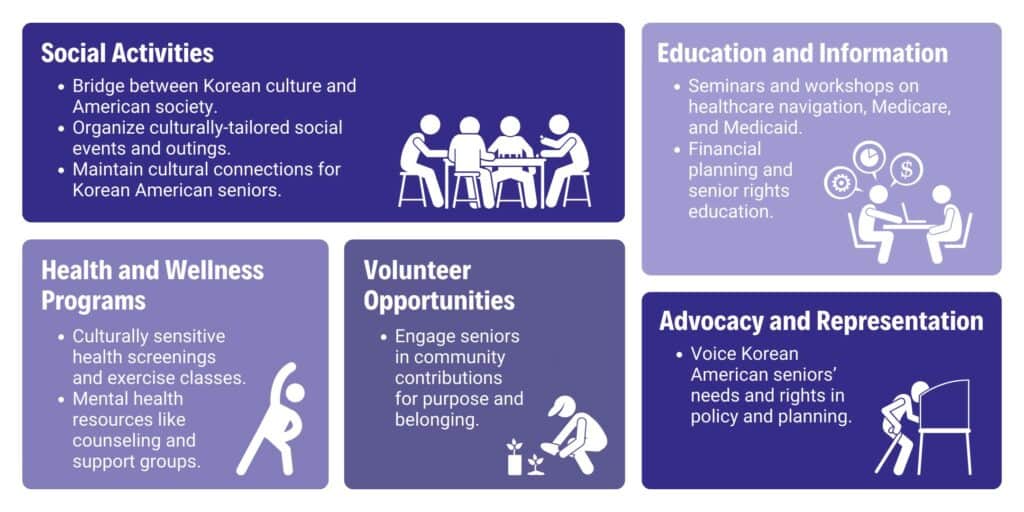
Addressing Policy Gaps for Aging in Place
Aging in place is a concept that involves remaining in one’s own home and community safely, independently, and comfortably—regardless of age, income, or ability level. Survey and focus group findings reveal that Korean seniors have a strong preference for this option. To effectively support aging in place among Korean seniors in the United States, it is essential to address a range of policy areas. This entails providing access to affordable housing, bridging language and cultural barriers to essential services, and overcoming transportation challenges. Strong support systems and comprehensive policy reforms are vital to meet the unique needs of this aging population and enable them to live with dignity and independence in their familiar environments.
The Affordable Housing Crisis and Seniors
Rising living expenses pose a challenge for seniors who depend on limited fixed incomes, highlighting the urgent need for affordable housing. Despite the availability of various subsidized housing and rental assistance programs (Figure 4), the U.S. continues to grapple with a severe shortage of affordable housing. The U.S. Census Bureau predicts that by 2030, 20% of the population will be of retirement age, which will raise the demand for such housing and worsen the problem.
Figure 4
Subsidized Housing and Rental Assistance Programs
The scarcity is more pronounced in densely populated cities like New York. According to a 2017 report by senior services organization LiveOn NY, there were around 19,700 seniors waiting for a mere 45 affordable housing openings annually in Manhattan Community Districts 7 and 9 (Upper West Side). The shortage has led to 7-10 year long waiting lists. Worse, seniors have to wait to turn 62 years of age to even get on the waitlist. Another striking example of the acute demand for affordable senior housing in the city was the Frances Goldin Senior Apartments in lower Manhattan. When they offered 99 units in January 2018, they received a staggering 65,000 applications.
There are not enough affordable housing units, and many of the options that are available do not offer easy access to vital services like healthcare, transportation, and social support. This is particularly true for the specific needs of Korean seniors. Korean seniors face additional challenges because many affordable housing options are far from their communities. They have to choose between living in an affordable area isolated from a familiar culture and language or living in an expensive place close to their friends and family. For example, properties within the Section 202 Housing for the Elderly Program or senior-specific public housing in New York City are mostly located far from areas with large Korean communities, as shown in Map 1. This geographic dislocation makes it harder for Korean seniors to access these housing options and utilize essential community-based resources at the same time.
Map 1
New York City Section 202 Properties and Public Housing Exclusively for Seniors
Many Korean American seniors want to age in place to remain close to important community and family networks, but the gentrification of their neighborhoods makes staying difficult. For example, gentrification in Los Angeles’ Koreatown over the past two decades, partly fueled by city developer incentive programs, presents a significant displacement risk, especially for those with limited mobility and fixed incomes. The building boom has attracted investors known as ‘vulture owners.’ They acquire rent-controlled buildings, capitalize on escalating rents, and employ predatory tactics to encourage long-standing tenants to leave. This strategy displaces long-standing community members and erodes affordable housing options in the area.
Lack of Transportation Alternatives
The U.S. transportation system, which largely assumes everyone has access to a car, fails to meet the needs of many seniors who can’t drive due to health or cognitive issues. Older adults who live in suburban and rural areas with scarce or non-existent public transit often find it difficult or even dangerous to get around. Even in cities with more developed public transit systems, like New York City, issues of limited accessibility and safety remain prevalent. Challenges include inadequate wheelchair access and seating, short times at crosswalks, and unsafe pedestrian pathways. These problems create significant risks for seniors and reveal the need for better infrastructure and services.
These issues are further compounded for Korean seniors with limited English proficiency who struggle to understand essential transit information like routes, schedules, and services, which are often only provided in English. Language and cultural barriers also cause Korean seniors to miss out on more convenient and cheaper services like curb-to-curb or door-to-door transit options (Box 3). These services offered by many states and cities are for those unable to use standard buses and trains. However, they need advance booking, require longer wait times, and use complex scheduling systems, which can be hard for seniors who struggle with English or digital technology.
Box 3
Government-Sponsored Senior Transportation Services
The Older Americans Act (OAA) Transportation Services, established under the Older Americans Act of 1965, provides various transportation aids for individuals aged 60 and over, especially those with greater social and economic needs. Administered by local Area Agencies on Aging (AAAs), these services can vary by community and include door-to-door or curb-to-curb transportation, reduced or free fare programs, volunteer driver programs, and coordination of existing transportation resources.
Medicaid Non-Emergency Medical Transportation (NEMT) benefits provide non-emergency medical transportation for Medicaid beneficiaries, ensuring access to medical care. It includes options like taxis, buses, and mileage reimbursement for personal vehicles or rides from others.
Americans with Disabilities Act (ADA) Paratransit Services provide door-to-door transportation for seniors with disabilities. They complement existing fixed-route services in communities with public transportation. Operating in the same areas and hours as regular transit, these services accommodate eligible riders’ special needs, typically at fares capped at twice the fixed-route cost for a similar trip.
Language Barriers and Access Challenges
A significant number of Korean seniors with limited English proficiency (LEP) find it difficult to access vital services such as finance, housing, transportation, and healthcare assistance programs. For example, Korean seniors with LEP require language support, resources, and information in Korean to apply for subsidized housing. Otherwise, they may not understand the application forms and guidelines, misunderstand application requirements, make mistakes, or miss the chance to get housing assistance altogether.
Korean seniors in the U.S. also face many healthcare challenges due to language barriers. They have trouble understanding English medical terms and insurance processes and finding Korean-speaking doctors and nurses. The scarcity of Korean-speaking medical personnel further hinders their ability to access and comprehend healthcare benefits, often leading to miscommunication, delayed or avoided treatments, and suboptimal care. There are not enough Korean-speaking caregivers at home or in places like nursing homes. This lack leads to problems with communication, understanding care instructions, trust between caregivers and patients, and feelings of being isolated. Therefore, Korean seniors need more language-appropriate services in healthcare and caregiving to ensure effective communication and receive better care.
Given these issues, there is a critical need for policies that mandate Korean language services across essential public sectors. This would ensure that Korean seniors receive accurate information, effective healthcare, and suitable care. Although there are some laws and legislative efforts underway to provide equal access to services, their implementation does not meet the unique needs of this group (Box 4). Issues include insufficient translation resources, inadequate awareness among service providers, and a lack of enforcement mechanisms. This affects not only Korean seniors but also other non-English speakers who are denied the full benefits of services because of language barriers. These implementation gaps must be fixed to make language access laws fulfill their intended purpose of inclusivity and equal access.
Box 4
City and State Legislation on Language Access
The Critical Role and Funding Challenges of Community-Based Organizations
Community-based organizations (CBOs) provide a vital bridge to essential services and support. Korean seniors in the U.S. These organizations help Korean seniors with their cultural and linguistic needs in healthcare, housing, and social services. However, because they are severely underfunded, they cannot connect with all the Korean seniors who desperately need help. Policy advocacy should focus on increasing funding for these CBOs. With more resources, these CBOs can meet the growing demands of the Korean senior population, enhance their well-being, and integrate into the broader community. Without this vital support, the service gap will continue to widen, leaving vulnerable Korean seniors behind and underserved.
Moreover, investing in CBOs by policymakers can be a strategic and cost-effective approach, particularly in the development of Naturally Occurring Retirement Communities (NORCs). As demonstrated in the case studies below, CBOs play an indispensable role in the ecosystem of NORCs by providing crucial services like healthcare coordination, social engagement activities, and caregiver support, which contribute to the overall health and well-being of seniors. These organizations ensure that NORCs transcend beyond mere physical spaces, evolving into vibrant communities with robust support systems attuned to senior needs. By supporting CBOs, policymakers can foster environments where seniors can age comfortably in their own homes and communities, reducing the need for more expensive institutional care. This not only enhances the quality of life for the elderly but also decreases healthcare costs associated with hospitalizations and long-term care facilities. Furthermore, NORCs supported by robust CBOs can reduce the financial strain on government-funded health and social service programs. In essence, the investment in CBOs and the nurturing of NORCs represent a sustainable model for senior care, offering a win-win scenario for both seniors and the broader economic health of communities.
Methodology
The Asian American Federation (AAF) developed surveys and organized focus groups to gain insights into the current situations and obstacles faced by the Korean American senior communities in New York City, New Jersey, the Washington DC Metropolitan area, Houston, Chicago, Los Angeles, and San Francisco. Seven community-based organizations (CBOs) collaborated with AAF in conducting these surveys and focus groups, including the Asian Women’s Christian Association (AWCA) of New Jersey, the Hana Center of Chicago, the Korean American Community Foundation (KACS) of San Francisco, Korean Community Services (KCS) of New York City, the Korean Community Service Center (KCSC) of Greater Washington D.C., the Korean Resource Center (KRC) of Los Angeles, and Woori Juntos of Houston.
Surveys
The survey used a convenience sampling method, focusing on Korean American seniors served by these organizations. As a national study, participants were selected from communities in seven key metropolitan areas across the United States. The sample was 50% female and 50% male. Half of the participants were aged between 50-64 years, and the other half were aged over 65 years. The survey specifically targeted Korean-speaking senior groups for language representation. Between May 31st, 2023 and June 30th, 2023, 819 Korean seniors participated in the in-person survey (Chart A).
Chart A
Survey Sample Size in Each Study Area
| Organization | Location | Targeted Sample Size | Responses Collected |
| AWCA | New Jersey | 100 | 107 |
| Hana Center | Chicago | 100 | 100 |
| KACS | San Francisco | 100 | 100 |
| KCS | New York City | 200 | 194 |
| KCSC | Washington D.C. | 100 | 118 |
| KRC | Los Angeles | 100 | 100 |
| Woori Juntos | Houston | 100 | 100 |
The surveys were originally developed in English and translated into Korean and were available only in paper form. Korean-speaking staff and volunteers helped participants with the surveys. The facilitators explained the purpose of the survey and that completing it meant taking part in the evaluation study. They also checked that respondents answered all the relevant questions. Before AAF analyzed the data, we translated the Korean responses into English and removed any private information to ensure privacy.
Each partner organization was given a microgrant of $2,000 to administer the survey. They could choose how to use this incentive to reward the participants.
Focus Groups
Chart B
Focus Groups Recruitment Criteria
| Organization | Target Location | Age Group | Gender Breakdown |
| AWCA | New Jersey | 50+ | 50% Male and 50% Female |
| Hana Center | Chicago | 50+ | 50% Male and 50% Female |
| KACS | San Francisco | 50+ | 50% Male and 50% Female |
| KCS | New York City | 50+ | 50% Male and 50% Female |
| KCSC | Washington D.C. | 50+ | 50% Male and 50% Female |
| KRC | Los Angeles | 50+ | 50% Male and 50% Female |
| Woori Juntos | Houston | 50+ | 50% Male and 50% Female |
From July 18th, 2023 until August 31st, 2023, the seven CBOs—AWCA, Hana Center, KACS, KCS, KCSC, KRC, and Woori Juntos—organized a total of eight in-person focus groups. Each organization held one focus group in their respective region, except in New York City where KCS conducted two focus groups. Each focus group had 10 Korean seniors from the same area.
Participants for the focus groups were recruited by the CBOs (Chart B) from survey respondents who qualified and showed interest. Of these, they selected ten suitable participants who could attend the focus group and agreed to sign an informed consent form. Additional participants were recruited to prepare for any no-shows. Partner organizations’ staff were trained online on effective focus group facilitation by the New York Academy of Medicine.
AAF also created a comprehensive moderator guide in English for the focus group sessions, which was also translated into Korean (downloadable link). Conducted entirely in Korean, these focus groups lasted approximately 120 minutes each. Participants were compensated with a $100 gift card, and refreshments were served during the sessions. To capture the discussions, the conversations were video-recorded, then transcribed and translated into English. These anonymized transcripts were subsequently sent to AAF for detailed analysis, ensuring participants’ privacy throughout the process.

